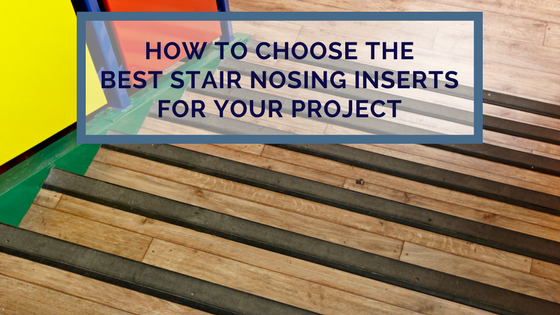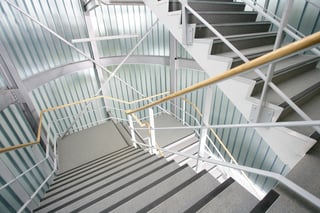
We’re often asked to give recommendations on the best stair nosing inserts for a particular installation. We get it - there are so many factors to consider, it can quickly become overwhelming. Of course, one of the first considerations is the inserts’ color, but there is so much more that goes into choosing the perfect stair nosing insert.
Here are the three main qualities you should consider to ensure you specify the best insert for your project.
Light Reflective Value (LRV)
 Basically, everything has a light reflective value, or LRV. LRV is simply the amount of light that is reflected off of the surface compared to the amount of light that falls on the surface.
Basically, everything has a light reflective value, or LRV. LRV is simply the amount of light that is reflected off of the surface compared to the amount of light that falls on the surface.
LRV is used to accommodate people with visual impairment - even though some people can’t determine colors, they usually can still see light and dark. LRVs are a great way to measure the contrast between two surfaces, making it easier for someone who is visually impaired to see the area. This is especially important on stairs.
LRVs are rated on a scale of 0 to 100, depending on the percentage of light that is reflected. Dark, matte, and/or textured surfaces absorb more light and have a lower LRV. Light, glossy, and/or smooth surfaces reflect the majority of the light that falls on them and have a higher LRV.
A good guideline to follow would be to ensure there’s a 30 point (not 30%) difference in the LRVs of the stair nosing and the insert.
Slip Resistance
 All Gradus inserts are tested for slip-resistance, surface roughness, and chemical and bacterial resistance. The independent test that was used to determine the slip-resistant factor is called the pendulum test (see page 4 of this leaflet from Gradus for details).
All Gradus inserts are tested for slip-resistance, surface roughness, and chemical and bacterial resistance. The independent test that was used to determine the slip-resistant factor is called the pendulum test (see page 4 of this leaflet from Gradus for details).
The Pendulum Test
Each insert is evaluated, then recomm
end for a specific purpose, such as interior dry or wet conditions, external conditions, etc. The rating for pendulum test values (PTV) begins at 0, which indicates a high slip potential, and goes up to 36+. Anything over 36 indicates that there is a low slip potential for that substance. All of Gradus’ stair nosing inserts far exceed the PTV of 36.
Have a specific profile in mind? Take a look on page 147 of the Gradus catalog to see the PTV rating of each insert.
Environment
 The environment in which the stair nosing will be installed plays a major part of your decision for an insert.
The environment in which the stair nosing will be installed plays a major part of your decision for an insert.
You will want to make sure that the insert you choose is rated for the conditions to which it will be exposed. Something as simple and picking an insert suited for interior dry conditions, when it’s going to get wet and possibly greasy, can impact the success of your stair nosing.
Make sure the profile and insert are going to be able to do what you need them to do. After all, you not only want an attractive installation, but you want one that will make the area safer.
If you have more questions about stair nosing inserts or any flooring accessory need, please contact us.




